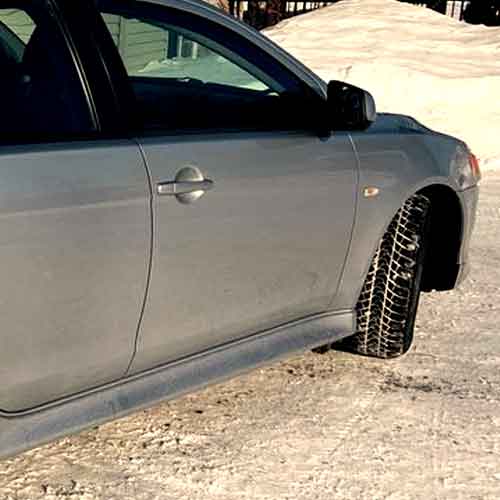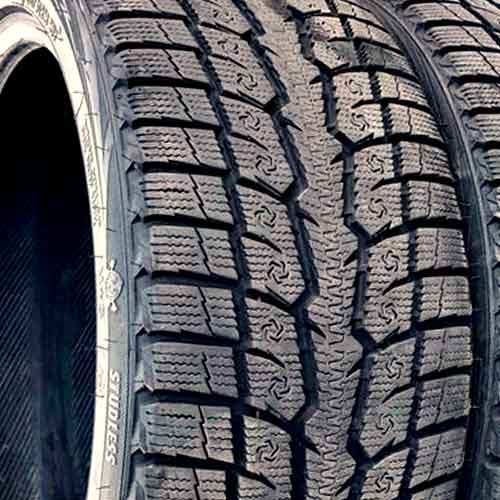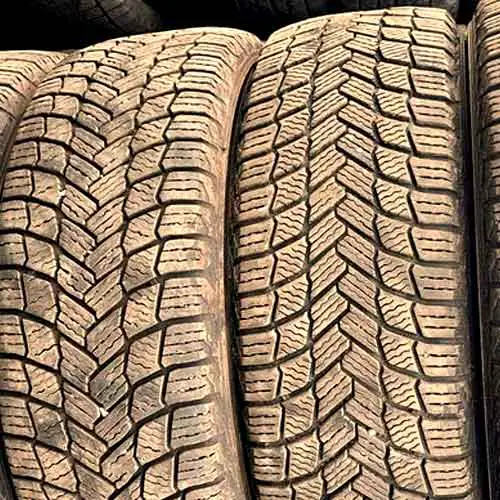Both Michelin X Ice Snow and Toyo Observe GSI 6 take the lead as premium winter tires, each demonstrating unique prowess in handling, tire life, and comfort, thus presenting various options to meet diverse driver preferences and road conditions.

Table of Contents
Available Sizes
The Michelin X-Ice Snow comes in 125 total sizes in 15 to 22 inches. They have following specs.
- Speed ratings: T and H.
- Load ratings: SL and XL.
- Tread depth: 10.5/32″ on all.
- Weight: 16 to 40 lbs.
- Tread warranty: 40k miles.
Review X-Ice Snow in greater details: https://snowytires.com/michelin-x-ice-snow-review/
On the other side, the Toyo Observe GSI 6 comes in 14 to 22″ with following.
- Speed ratings: H and V.
- Load ratings: SL and XL.
- Tread depth: 11 to 12.6/32″.
- Weight: 17 to 41 lbs.
- Tread warranty: None.
Tread Pattern
Starting with the Toyo Observe GSI 6, the tire showcases a directional pattern.

Upon examining its tread, it is noticeable that it is divided into three parts, or ribs, effectively forming columns of blocks in the center. These three ribs generate four longitudinal channels of equal width, with the exterior channels possessing enhanced biting attributes.
The central-most rib presents as continuous, as the slits evident do not fully partition it. These slits are plentiful, creating a zigzag pattern that runs the length of the tire.
Furthermore, this rib is adorned with sharp notches and a combination of rectilinear and interlocking siping.
The adjacent ribs are open, crafting interconnected grooves teeming with biters. Notable features include the snow vices facing the shoulders, numerous notches, off-set edges, and ample siping. An unmissable detail is the flower or snowflake-shaped deep incisions.
A similar narrative unfolds with the shoulder lugs. They exhibit snow vices, zigzag slits at the core, and of course, wave-like siping.
In contrast, the Michelin X-Ice Snow also showcases a distinct and directional tread design.

Six ribs in total are discernible in the design of the this tire’s tread.
In the very heart of the tread, there is notable inter-connectivity among the tread voids.
These voids consist of blocks with thick siping slits arranged in a wave-like pattern. Along with chamfered edges and offset sides, they feature snow vices, facilitating outstanding snow traction.
The blocks further out start to take a more squared-off shape and are not equipped with as many biting edges.
However, the shoulder lugs tell a different story.
They exhibit significantly more aggressive overall siping and are finished with zigzag serrated edges on their lateral sides.
Wet Traction
Wet traction is fundamentally governed by two components: the design of the tread and the formulation of the rubber.
These elements shape the tire’s grip and hydroplaning resistance, which are the two key aspects of wet performance.
Let’s delve deeper on these dimensions.
Wet Grip
Although both tires employ plentiful siping and flexible tread rubber, the Michelin X-Ice Snow falls somewhat short.
The Toyo Observe GSI 6 gives you a central rib patterned with zigzag slits, along with an array of rectilinear and interlocking sipes, supplemented by notches.
Even its surrounding blocks showcase snowflake shaped slits and snow vices oriented towards the shoulders.
All these structures enable superior water absorption and expulsion capabilities, creating a suction-like effect that enhances the tire’s overall wet grip.
Conversely, the Michelin X-Ice Snow, despite its dual siping design and multi-angled biters, trails behind the Toyo tire in this aspect, showing slightly longer handling lap times on average.
Winner: Toyo Observe
Hydroplaning resistance
Hydroplaning is a dangerous situation that arises when a layer of water forms a barrier between the tire tread and the road surface, causing the tire to ‘float’ and lose traction.
In this regard, the Toyo Observe GSI-6 exhibits a commendable performance, enabled by its wide channels and sweeping arms that allow for higher hydroplaning speeds in both straight-line and curved scenarios.
Moreover, the tire’s elaborate network of channels is designed to disperse water efficiently in all directions, enhancing overall hydroplaning resistance.
Winner: Toyo Observe
Tread Life
Tread life is significantly affected by rolling resistance, a variable dependent on the tire’s weight and the composition of its rubber.
Given this principle, the Toyo Observe GSI 6 unfortunately lags behind. Its heavier weight applies more pressure on the tread, causing each lug to endure more friction against the road due to their wider spacing. This is further aggravated by the tire’s relatively softer rubber compound.
On the other hand, the Michelin X-Ice Snow, being lighter and having closely-packed lugs, experiences less friction during road contact, leading to slower tread wear.
So, overall, the tread of the Toyo Observe GSI 6 tends to wear out faster.
Winner: Michelin X Ice
Snow Performance
In terms of soft snow performance, the Toyo Observe GSI 6 edges slightly ahead due to its numerous gaps and biters which effectively trap snow particles, fostering snow-to-snow interaction.
This trapping of snow forms the primary contact patch with the ground as the tire spins, improving traction since snow adheres more readily to itself than to rubber.
In addition, the directional pattern of the tire’s tread facilitates a paddling effect, scooping and propelling snow backwards and thereby creating forward momentum.
Conversely, the Michelin X-Ice Snow lacks these attributes. It employs a less aggressive overall pattern and doesn’t provide as effective a snow-to-snow contact.
Winner: Toyo Observe
Fuel Economy
Fuel efficiency in a tire is fundamentally connected to its tread design and overall weight, both of which contribute to rolling resistance.
Simply put, a heavier tire with larger tread gaps will cause increased flexing of the tire lugs during maneuvers like cornering, braking, or accelerating.
This flexing or deformation of the lugs results in extra energy consumption, which is the case with the Toyo Observe GSI 6.
On the other hand, the Michelin X-Ice Snow, with its more streamlined, longitudinally aligned ribs, doesn’t generate as much rolling resistance. Consequently, it fares better in terms of fuel economy.
Winner: Michelin X Ice
Comfort Levels
Comfort in a tire is primarily determined by the level of road noise and its capacity to absorb vibrations.
Starting with road noise, which is produced by the interaction of air particles with the tread pattern, the Toyo Observe GSI 6 leaves some room for improvement.
Broadly speaking, the wider the tread gaps, the higher the noise produced. With its comparatively open tread design, the Toyo GSI 6 falls short in maintaining a quieter ride.
However, when considering vibration absorption, the Toyo Observe GSI-6 eclipses its counterpart, the Michelin X-Ice Snow.
Owing to its softer tread compound, the tire excels at absorbing shocks, ensuring a generally smoother ride.
Winner: Michelin X Ice
Dry Traction
Dry traction can be evaluated along two lines: directional grip and handling. Let’s investigate both.
Directional Grip
Dry grip largely depends on the central area of the tread since it makes the most contact with the road, especially in winter tires with their rounded contact patches and directional designs.
In this context, the Toyo takes the lead, featuring a continuous, wider central rib that ensures an uninterrupted interaction between the rubber and the road. This results in shorter braking distances, which is indicative of better directional grip.
Contrarily, the Michelin X Ice Snow falls short with its missing continuous running rib in the very middle, like its counterpart.
Winner: Toyo Observe
Handling
The handling or cornering ability of a tire largely depends on its shoulder lugs. Here, two factors are taken into consideration.
Firstly, the effectiveness of the lugs’ ground contact as the tire rotates. Secondly, the degree to which these lugs deform during this process.
In both aspects, the Michelin X-Ice Snow comes out on top. Its compact pattern provides a larger contact patch with the ground, and due to its lighter weight, its lugs don’t flex excessively during cornering.
During cornering, most of the tire’s weight shifts towards the shoulders, and any bending of these lugs disrupts the balance between oversteer and understeer, resulting in slower steering response.
Therefore, due to its heavier construction and wider channels, the Toyo Observe GSI 6 records longer handling lap times.
Winner: Michelin X Ice
To Conclude
Both tires are premium winter options, each excelling in different areas.
The Observe GSI-6 outperforms in wet traction and soft snow performance, thanks to its numerous sipes and tread gaps. However, its wider grooves contribute to greater road noise, compromising ride comfort.
In contrast, the Michelin X-Ice Snow delivers outstanding performance in dry traction and fuel economy, courtesy of its continuous central rib and lighter weight, though it lags in hydroplaning resistance.
Moreover, despite their distinct strengths, the Observe GSI-6 experiences faster tread wear, while the Michelin X-Ice Snow provides a smoother ride, demonstrating that each tire caters to specific needs depending on the driving conditions.